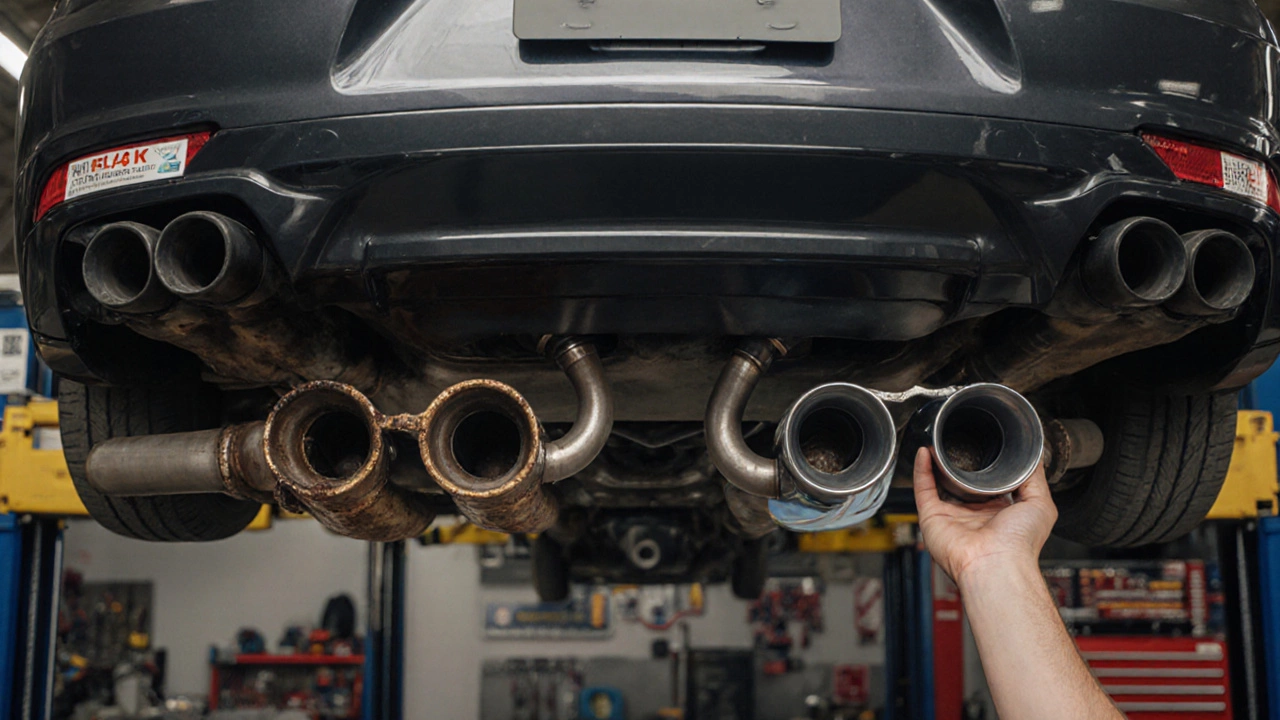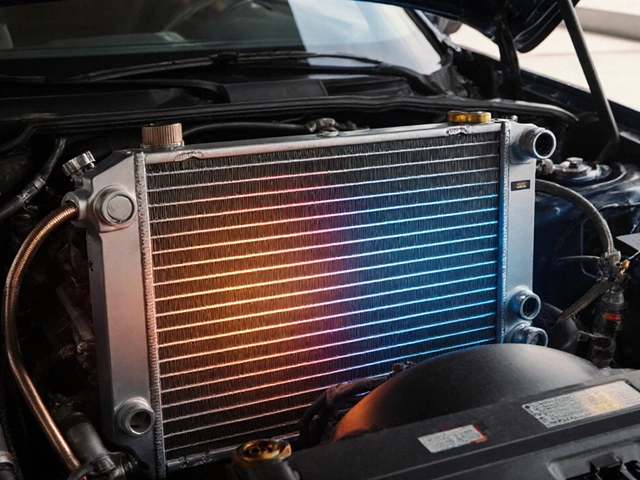Buying a new exhaust isn’t just about making your car sound louder. If you get it wrong, you could lose power, fail emissions, or even damage your engine. Too many people jump into buying an exhaust because they saw a flashy YouTube video or heard a neighbor’s car rumble - only to regret it months later when their ride feels sluggish or gets flagged by road inspectors.
Know Your Exhaust’s Job
An exhaust system doesn’t just let fumes out. It manages backpressure, reduces noise, cools gases, and helps your engine breathe efficiently. A stock exhaust is tuned for balance: power, fuel economy, noise, and emissions. When you swap it out, you’re changing that balance.
Think of it like shoes. You wouldn’t put running shoes on a hiking trail and expect the same performance. Same with exhausts. A track-focused system won’t work well for daily driving. And a quiet, stock-style replacement won’t give you the punch you’re after if you’re chasing performance.
Understand the Parts
Exhaust systems aren’t one-size-fits-all. They’re made of several components, and each affects performance differently:
- Headers - The first part that connects to the engine. Stainless steel headers improve flow over stock cast iron.
- Mid-pipe - Connects the headers to the catalytic converter or resonator. A larger diameter here can reduce restriction.
- Catalytic converter - Required by law in most places. Removing it is illegal and will fail emissions tests.
- Resonator - Reduces drone without killing power. Often confused with a muffler.
- Muffler - Controls sound. Some are designed for quiet operation, others for aggressive tone.
- Tip - The visible end. Mostly cosmetic, but can affect airflow slightly.
Most aftermarket kits replace the mid-pipe, muffler, and tips. Full systems include headers and downpipes too. Know what you’re actually getting before you pay.
Legal and Emissions Rules Matter
In Australia, the Road Transport (Vehicle Registration) Regulation 2017 says your exhaust must not be louder than the original equipment. Police can pull you over if your exhaust is deemed excessively noisy - even if it’s not illegal on paper. Some states, like Victoria and NSW, have strict noise testing during registration.
Removing the catalytic converter is illegal everywhere in Australia. You’ll fail emissions testing, and your car won’t pass inspection. Some sellers claim their systems are "cat-free" for performance. Avoid them. You’re not just breaking the law - you’re risking a $500+ fine and a mandatory repair.
Look for systems labeled "AUSTROADS compliant" or "EPA approved". Reputable brands like Milltek, Borla, and Redline4x4 list compliance details on their websites. If they don’t mention it, assume it’s not legal.
Material Choices: Stainless Steel vs. Aluminized
Exhausts are usually made from two types of steel:
- Aluminized steel - Cheaper, but rusts faster. Lasts 3-5 years in coastal areas like Adelaide, where salt air eats metal.
- Stainless steel (304 or 409) - More expensive, but resists rust, heat, and corrosion. 304 is higher grade and lasts 10+ years. 409 is more affordable and still lasts 7-10 years.
Don’t buy an aluminized exhaust if you live near the coast or drive in wet conditions. I’ve seen people replace their exhaust every two years because they saved $200 upfront. In the long run, stainless pays for itself.

Sound: What You Want vs. What You’ll Get
Everyone wants that deep, throaty rumble. But sound isn’t just about the muffler. It’s a mix of engine size, pipe diameter, and backpressure.
Here’s what actually happens:
- Too thin a pipe (under 2.5 inches) = more backpressure = less power at high RPM.
- Too thick a pipe (over 3 inches) = too little backpressure = poor low-end torque, especially in naturally aspirated engines.
- Double-wall tips look cool but add no performance.
- Resonators reduce cabin drone without killing power - a must for daily drivers.
Listen to real-world videos of the exact system on your car model. YouTube clips with identical setups (same engine, same year, same tire size) are more reliable than shop demos. A system that sounds amazing on a 3.5L V6 might drone like a lawnmower on a 2.0L four-cylinder.
Performance Gains Are Often Overhyped
Most bolt-on exhausts give you 5-10 horsepower - if you’re lucky. That’s not a game-changer. The real benefit is better throttle response and a smoother power curve.
If you want real gains, you need to pair the exhaust with a tune. A cold air intake + exhaust + ECU remap can add 20-30 hp. But tuning costs $500-$800. Don’t expect magic from a muffler alone.
For turbocharged cars, a cat-back exhaust can improve spool time and reduce heat soak. For naturally aspirated engines, the gains are smaller. Know your engine type before spending.
Fitment Is Everything
Not all "universal" exhausts fit your car. Even if the inlet/outlet sizes match, the hangers, bends, and clearance points might not.
Check for:
- Clearance over the fuel tank, differential, and rear suspension.
- Mounting points matching your factory hangers.
- Clearance with the spare tire or underbody panels.
Buy from a vendor that lists your exact vehicle make, model, and year. If they say "fits most 2015-2020 Camrys," they’re being vague. Look for listings that say "fits 2017 Toyota Camry 2.5L 4-cylinder with factory catalytic converter."
Pro tip: Bring your old exhaust with you when you pick up the new one. Lay them side by side. Compare the bends and hanger positions. If they don’t match, don’t install it.

Installation: DIY or Pro?
Most cat-back systems can be installed in 2-4 hours with basic tools. But if your old exhaust is rusted, you could spend hours cutting bolts or dealing with seized hangers.
Here’s what to expect:
- Easy: Bolt-on systems with factory-style hangers.
- Hard: Systems requiring cutting, welding, or modifying brackets.
If you’re not comfortable with jack stands, wrenches, and penetrating oil, pay a shop. A $150 labor fee saves you a day of frustration and potential damage.
Also, never reuse old gaskets. Always use new ones. A leaky exhaust smells like rotten eggs and can let carbon monoxide into your cabin.
What to Avoid
- "Free shipping" exhausts from Amazon or eBay - low quality, no warranty, often mislabeled.
- Systems that don’t list material grade (304 vs. 409 stainless).
- "Race-only" exhausts sold as street legal.
- Claims of "50+ HP gains" from a muffler alone.
- Brands you’ve never heard of with no reviews or customer photos.
Stick with brands that have been around for 10+ years and have Australian distributors. Brands like SRT, Supersprint, and Invidia have local support and warranty claims you can actually use.
Final Checklist Before You Buy
Before you hand over your money, ask yourself:
- Is this system legal for road use in my state?
- Is it made from stainless steel (304 or 409)?
- Does it fit my exact car model and engine?
- Will it improve my driving experience - or just make noise?
- Is there a warranty? (At least 2 years, preferably lifetime.)
- Do real owners of my car model like it? (Search YouTube + forums.)
If you answered yes to all five, you’re ready. If not, keep looking.
What’s the Best Value?
For most daily drivers in Australia, a 304 stainless steel cat-back system with a resonator and quiet performance muffler is the sweet spot. Brands like Milltek Sport and Borla offer systems that sound great without being obnoxious, last over a decade, and pass inspections without issue.
Don’t buy the cheapest option. Don’t buy the loudest. Buy the one that matches your driving style, your climate, and your legal limits. A good exhaust isn’t about bragging rights. It’s about making your car work better - for years to come.
Can I remove the catalytic converter for more power?
No. Removing the catalytic converter is illegal in Australia and will cause your car to fail emissions testing. It also increases harmful pollutants. Even if you don’t get caught, you won’t pass registration. Performance gains are minimal without a tune, and you risk fines, vehicle impoundment, or being forced to reinstall the original part.
Will a new exhaust improve fuel economy?
Sometimes, but not usually. A properly designed exhaust can reduce engine strain, which may improve fuel efficiency by 1-3%. But if the system is too large or poorly tuned, it can hurt fuel economy. Most people won’t notice a difference unless they drive aggressively. Don’t buy an exhaust expecting big savings on gas.
What’s the difference between a cat-back and a full exhaust system?
A cat-back system replaces everything from the catalytic converter back - muffler, pipes, tips. A full system replaces everything, including the headers and downpipe. Full systems offer more performance gain but cost more and require more work to install. For most drivers, a cat-back is enough. Full systems are for enthusiasts or modified engines.
Why does my new exhaust drone at highway speeds?
Drone happens when exhaust frequencies match your car’s cabin resonance, usually between 1,800-2,500 RPM. It’s common with straight-through mufflers on four-cylinder engines. The fix? Install a resonator, switch to a chambered muffler, or choose a system designed for your specific engine. Avoid "performance" mufflers that say "no drone" - they’re often lies.
How long should an exhaust last?
Aluminized steel lasts 3-5 years, especially near the coast. Stainless steel (304) lasts 10-15 years or more. If your exhaust rusts through in under two years, it’s low quality. Look for lifetime warranties on stainless systems - they’re a sign of confidence in the product.
Do I need to tune my car after installing a new exhaust?
Not always. Most cat-back systems don’t require a tune. But if you’re installing headers, a high-flow catalytic converter, or a full system on a turbocharged car, a tune helps optimize air/fuel ratios and prevent check engine lights. For basic upgrades, a tune isn’t needed - but it can unlock extra power.




